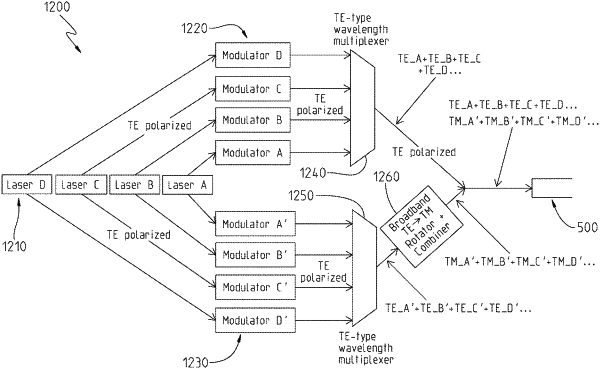| CPC G02B 6/4213 (2013.01) [G02B 6/126 (2013.01); G02B 6/1228 (2013.01); G02B 6/2726 (2013.01); G02B 6/2766 (2013.01); G02B 6/2773 (2013.01); G02F 1/01 (2013.01); H04B 10/50 (2013.01); G02F 1/025 (2013.01)] | 6 Claims |

|
1. A method of transmitting a plurality of optically modulated signals for output to a fiber system, the method comprising the steps of:
providing a first laser source configured to emit light of a first wavelength having a first polarization and a second laser source configured to emit light of a second wavelength having the first polarization, the second wavelength being different than the first wavelength;
receiving a first portion of the light emitted by the first laser source with a first modulator and a second portion of the light emitted by the first laser source with a second modulator;
receiving a first portion of the light emitted by the second laser source with a third modulator and a second portion of the light emitted by the second laser source with a fourth modulator;
outputting a first modulated optical signal from the first modulator, the first modulated optical signal having the first polarization;
outputting a second modulated optical signal from the second modulator, the second modulated optical signal having the first polarization;
outputting a third modulated optical signal from the third modulator, the third modulated optical signal having the first polarization;
outputting a fourth modulated optical signal from the fourth modulator, the fourth modulated optical signal having the first polarization;
multiplexing the first modulated optical signal and the third modulated optical signal to provide a first multiplexed optical signal having the first polarization;
multiplexing the second modulated optical signal and the fourth modulated optical signal to provide a second multiplexed optical signal having the first polarization;
altering the second multiplexed optical signal to have a second polarization, the second polarization being different from the first polarization; and
combining the first multiplexed optical signal having the first polarization and the second multiplexed optical signal having the second polarization into a third optical signal.
|